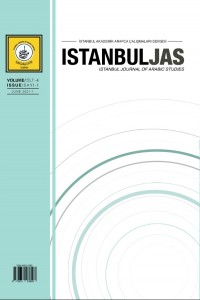Aḥmed el-Ġarḳāvî’nin “Vechu S̱ubûti’l-Vâv fî Ḳavlihî Teâlâ: Ve Futiḥat Ebvâbuhâ” Adlı Risâlesinin Tahkiki
Abstract
References
- Ahmed Se‘alebî, el-Keşf ve’l-Beyân, Tah. Ebu Muhammed ‘Âşûr, Beyrut: İhyau’t-Turâsi’l-‘Arabî, 1422.
- Ahmed el-Hafâci, ‘İnâyetu’l-Kâdi ve Kifâyatu’l-Râdi ‘ala Tefsîr el-Beyzavî, Beyrut: Dâru Sâdır, 1978.
- Ahmed es-Sebkî, ‘Urusu’l-Efrâh, Tah. ‘Abdulhamîd Hendâvî, Beyrut, el-Meketebetu’l-‘Asriyye, 1423.
- Ahmed Teymur Bâşa, Fihrisu’l- Hazeneti’t-Teymuriyye, Kahire: el-Meketebetu’l-Mısrıyye, 1948.
تحقيق رِسَالَة أَحْمَدَ بنِ أَحْمَدَ الغَرْقَاوِيِّ فِي وَجْهِ ثُبُوْتِ الوَاوِ فِي قَوْلِهِ تَعَالَى: (وَفُتِحَتْ أَبْوَابُهَا)
Abstract
تناولنا في هذا البحث رسالةٌ وجيزةٌ، تعلَّقَ بالدِّراساتِ القرآنيَّةِ العربيَّةِ نحًوا وصرفًا وبلاغًة التي صنَّفَهَا علمٌ من أعلامِ القرنِ الثَّاني عشرَ من الهجرةِ النَّبويَّةِ الإمامُ العلَّامةُ الأزهريُّ أحمدُ بنُ أحمدَ الغرقاويُّ، فاستعنَّا باللهِ تعالى الَّذي لا يعبدُ بحقٍّ سواه، فعكفْنَا عليها تحقيقًا ودراسةً مستفيدينَ ممّا تركَهُ لنا جهابذةُ التَّحقيقِ في زمنِنَا المعاصرِ من مصنفاتٍ نافعةٍ، وكتبٍ رائعةٍ . وقدْ جعلْنَا العمل في هذه الرِّسالة على قسمين: في القسم الأوّل: تحدّثنا فيه عن ترجمة المصنّف: اسمه ولقبه ونسبه، وشيوخه وتلامذته، ومكانته العلميّة، ومذهبه العقديّ والفقهيّ، ومصنّفاته، وتاريخ وفاته. وفي القسم الثّاني: تحدّثنا فيه عن رسالة المصنّف: تحقيق اسم الرّسالة، وتوثيق نسبتها إلى المصّنف، وبيان النّسخ المعتمدة في التّحقيق، والمضمون العامّ للرّسالة، ومكانتها العلميّة.
References
- Ahmed Se‘alebî, el-Keşf ve’l-Beyân, Tah. Ebu Muhammed ‘Âşûr, Beyrut: İhyau’t-Turâsi’l-‘Arabî, 1422.
- Ahmed el-Hafâci, ‘İnâyetu’l-Kâdi ve Kifâyatu’l-Râdi ‘ala Tefsîr el-Beyzavî, Beyrut: Dâru Sâdır, 1978.
- Ahmed es-Sebkî, ‘Urusu’l-Efrâh, Tah. ‘Abdulhamîd Hendâvî, Beyrut, el-Meketebetu’l-‘Asriyye, 1423.
- Ahmed Teymur Bâşa, Fihrisu’l- Hazeneti’t-Teymuriyye, Kahire: el-Meketebetu’l-Mısrıyye, 1948.
Investigation of the Epistle of Ahmad al-Gharqāwī Regarding the Proof of the Waw Letter in the Verses of the Quran
Abstract
The Grand Mufti of the Ottoman Empire in Egypt at that period of time, pointed out that the letter waw was used in the 73th verse of the Surah al-Zumar mentioning the heaven but not used in the 71st verse mentioning the hell. He then requested from Ahmad al-Gharqāwī, who was the most prominent scholar of the Maliki sect, to write an epistle about the subject. Upon this request, al-Gharqāwī tried to interpret the verses mentioned above by referring to the opinions of different commentators. He included the opinions of linguists from Basra and Kufa. He participated in some of the opinions of both the commentators and the linguists on the subject, and refuted some of them by revealing the logical and religious evidence. An important research subject in terms of Arabic language, the art of rhetoric, Quranic performance and interpretation, this epistle is a valuable study that reveals the subtle style and nucleus found in both verses.
References
- Ahmed Se‘alebî, el-Keşf ve’l-Beyân, Tah. Ebu Muhammed ‘Âşûr, Beyrut: İhyau’t-Turâsi’l-‘Arabî, 1422.
- Ahmed el-Hafâci, ‘İnâyetu’l-Kâdi ve Kifâyatu’l-Râdi ‘ala Tefsîr el-Beyzavî, Beyrut: Dâru Sâdır, 1978.
- Ahmed es-Sebkî, ‘Urusu’l-Efrâh, Tah. ‘Abdulhamîd Hendâvî, Beyrut, el-Meketebetu’l-‘Asriyye, 1423.
- Ahmed Teymur Bâşa, Fihrisu’l- Hazeneti’t-Teymuriyye, Kahire: el-Meketebetu’l-Mısrıyye, 1948.
Details
| Primary Language | Arabic |
|---|---|
| Subjects | Linguistics, Creative Arts and Writing |
| Journal Section | Articles |
| Authors | |
| Publication Date | June 14, 2021 |
| Submission Date | February 17, 2021 |
| Acceptance Date | April 26, 2021 |
| Published in Issue | Year 2021 Volume: 4 Issue: 1 |


